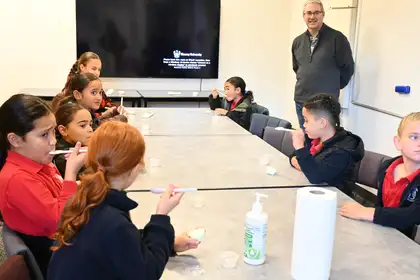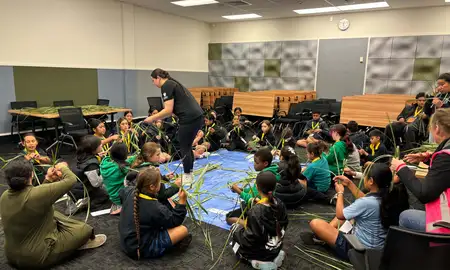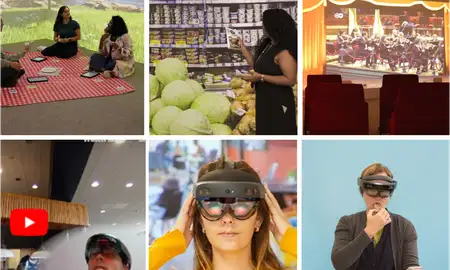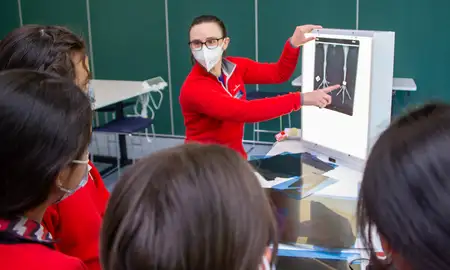
School students during a tasting session.
The children from the school’s Māori immersion unit were visiting the Te Kunenga ki Pūrehuroa Massey University's School of Food Technology and Natural Sciences and the Riddet Institute to learn all about the sensory perception of ice cream and some food technology. They also made plastic from milk.
Associate Professor Jon Palmer and Associate Professor Nicola Brown hosted the food technology day as a way of making science fun and tasty.
The tamariki participated in three experimental sessions. Firstly, they explored colour and taste, as often, perception of flavour is related to what we see. Massey scientists showed the children an ice cream and asked them to guess the flavor. They then smelt the ice cream and tried again. The fun part was that the flavor was totally unrelated to the color. The pink ice cream was banana flavoured and the green ice cream was orange flavoured.
Next on the menu was freeze dried ice cream, affectionately known as astronaut ice cream as the space station cannot accommodate a freezer. This ice cream product was showcased at Massey’s Fieldays stand in 2022 and is produced in our Food Pilot.
Freeze dried ice cream is manufactured by freeze drying regular ice cream and can be broken up into chunks to make it have a meringue-like texture. Dr Palmer explained that the ice cream shrinks to half its original volume with its water removed and no longer requires freezing or even refrigerating as it cannot melt. Instead, it is stored in vacuum packs and can last for months, as long as it is not exposed to the sun.
“We showed the children experiments and examples we use with our adult students. This is all part of food technology, developing and making food. What you see has a huge role in what we taste, and it is great fun to fool our senses, Dr Palmer says.
Dr Brown explained that freeze dried ice cream could go to the moon with astronauts, but also had practical uses down on earth. It could be taken tramping or used as a snack for extreme sportspeople as it contained nutritious protein and fats.
The final experiment was making plastic from food products. Three Riddet Institute Postdoctoral Fellows, Dr Thomas Do, Dr Mahya Tavan and Dr Faith Descallar, and Riddet Institute PhD student Patricia Soh, led the ‘milk plastic’ mini workshops with three groups of school students.
The casein component of milk gels once milk is warmed and curdled by adding vinegar. The curds solidify and can be molded into shapes that later set hard as plastic.
Linton Camp School teacher Kayla Cousins says the tamariki had an amazing time at the visit and soaked up the science learning.
“I forsee a lot of milky plastic being made at home in the future,” she says.
Student Nikolai enjoyed guessing the flavours of the ice creams.
“It tastes like lime first and then orange when you swallow."
Related news
A taste of university life for Children’s University ākonga
Almost 300 ākonga have been acquainted with university life through Discovery Days on the Pukeahu Wellington and Manawatū campuses over the past fortnight.

Feast Laboratory: The virtual all-around tasting experience
With 80 per cent of new products failing in the marketplace, conducting consumer testing beforehand becomes imperative, highlighting the potential for virtual reality technologies to revolutionise predictions of consumer acceptance.

Discovery Day sees tamariki explore what’s on offer at Manawatū campus
A group of 85 tamariki from four Palmerston North schools spent a day on Massey’s Manawatū campus recently, as they took part in the first-ever Discovery Day as part of the Wānanga Nohinohi Te Kunenga Children’s University programme.
